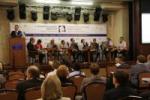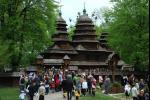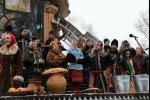- عربي
- Ukraine
- Economy
-
Investment
- Current Investment Trends
- Legal Conditions of Doing Business
- Investment Policy
- Competition
- Setting a Business in Ukraine
- Mergers and Acquisitions
- Taxation
- Import and Export
- Banks and Bank Regulation
- Convertibility and Profits Repatriation
- Currency Regulation
- Protection of Intellectual Property Rights
- Companies
- Travel to Ukraine
- About us
- Useful Sites
- Gallery
- News
Currency rates in UAH
| AED | ||
| BHD | ||
| EGP | ||
| KWD | ||
| LBP | ||
| OMR | ||
| QAR | ||
| SAR | ||
| SYP |
2015-07-06
| Kiev |  |
+32 |
| Donetsk |  |
+28 |
| Dnipropetrovsk |  |
+31 |
| Lviv |  |
+31 |
| Odessa |  |
+27 |
Ukraine of the 19th Century
Eastern Ukraine that occupied by the Russian monarchy included the lands of the Left Bank, Slobodian, Right Bank Ukraine, and the region of the South. During the 19th century,
Tsarism pursued a course of Russification of the Ukrainian population of
The liberation traditions of Ukrainians began their renaissance in the early 19th century. It first began in circles of national intellectuals which were mostly made up of Ukrainian writers. The activities of the Kharkiv romantics - Ukrainian subjects in works by M. Hohol - were of great significance for preserving the spirits of Cossacks' victories. In the future, their cause was continued by Ivan Franko, Lesya Ukrainka, P. Hrabovskyi, and Taras Shevchenko. The Ukrainian national cultural renaissance was favored by the opening of the Kharkiv (1805) and Kyiv (1834) Universities by the founding of a popular paper, "Ukrainskyi vesnik" (1816-1863), the scientific literary journal, "Osnova" (1861-1863), and the first historical paper in
During the first decades of the 19th century the Ukrainian national culture movement was closely connected with the political one. A lot of Ukrainians were the acting members of general Russian Masonic organizations, which proclaimed the creation of "judicious society" of the people with equal rights and targeted their activities. They took part in secret officers' societies that were oriented against the Russian monarchy. The population on the
The activities of the Brotherhood of St. Cyril and Methodius were an important point on the path of the consolidation of the national liberation movement. This was a non-legal political organization created in Kyiv in 1846 by representatives of the Ukrainian national intelligentsia. Taras Shevchenko also spread the national liberation ideas in his poetic works. The attainment of state independence of
Having been spread in national consciousness, these ideas were developed in the social movement of the late 19th century. Members of these often illegal organizations were united by the calls of Ukrainism and the devotion to their people and pride in their history. The social workers were mainly busy in cultural and educational work. They organized schools, issues textbooks and popularized folklore.
The liberation and social ideas were also spread among the working class in
The social struggle developed with new force in the late 19th century. In the mid-1850s, the peasants' movement embraced 422 villages of the Kyiv, Katerynoslav and
A new stage of the liberation movement in
The 20th century was marked by the considerable aggravation of the revolutionary struggle. The first Ukrainian political parties (The Revolutionary Ukrainian Party, Ukrainian Socio-democratic Workers' Party, The Society of Ukrainian Progressionists) were under its influence. Their leaders were D. Antonovych, O. Lototskyi, V. Vynnychenko, S. Petliura, S. Yefremov and others. Some of these individuals became prominent figures of the future Ukrainian revolution.
Except for the Draconian laws of Tsarism of 1863 and 1876 with regards to the Ukrainian language, the development of Ukrainian culture rose to a new level. It became an important factor of national renaissance. The creative work of M. Hrushevskyi (e.g., the multi-volume "History of Ukraine-Rus"), works by B. Hrinchenko, A. Krymskyi, and M. Arkas were noticeable literary landmarks. Pressing social and national problems were addressed in the works of many poets.
The state of Ukrainians in the lands subject to the Austro-Hungarian Empire in the 19th century was not less complicated than of those in the
In April 1848,
In the 19th century, there were certain changes in the socio-political life of the region. The activation of the enlighteners' ideas and the furthering of the ideology of romanticism, which was caused by the rise of the liberation movement on the European continent and this favored the intense processes of national renaissance. The first cultural-educational circles appeared in Peremyshl and Lviv. Interests in the history of the land, language and folklore considerably increased at this time. However, the decisive part in the development of the national movement at that time belonged to the socio-cultural association "Ruska triitsia". The motives of the liberation of the region were seen on the pages of publicists' articles, almanacs, and school textbooks.
The revolutionary events of 1848-1849 had broad resonance in the West Ukrainian lands. The first Ukrainian political organization, the Chief Rus Council, appeared in Lviv in 1848. Its program documents were filled with ideas of autonomy, democracy, and reformation in different spheres of political and intellectual life of the region. Revolutionary events enlivened the Ukrainian national liberation movement in
The national movement was not stopped after the revolution was suppressed. Representatives of younger generations of the intelligentsia founded youth organizations such as: communities in Lviv, Berezhany, Peremyshl, Sambir, Ternopil, and Stanislav. The whole group of outstanding political figures of
The development of the national liberation movement in the Western Ukrainian lands was not isolated, but was in close relations with analogous processes in



